List of Contents
Sewing Thread Market Size and Forecast 2025 to 2034
The global sewing thread market size accounted for USD 3.69 billion in 2024 and is predicted to increase from USD 3.79 billion in 2025 to approximately USD 4.84 billion by 2034, expanding at a CAGR of 2.74% from 2025 to 2034.The market is witnessing rapid growth because sewing thread is a fundamental component in the production of countless goods, from apparel and footwear to home textiles and technical textiles. Sewing threads ensure the quality and longevity of finished products.
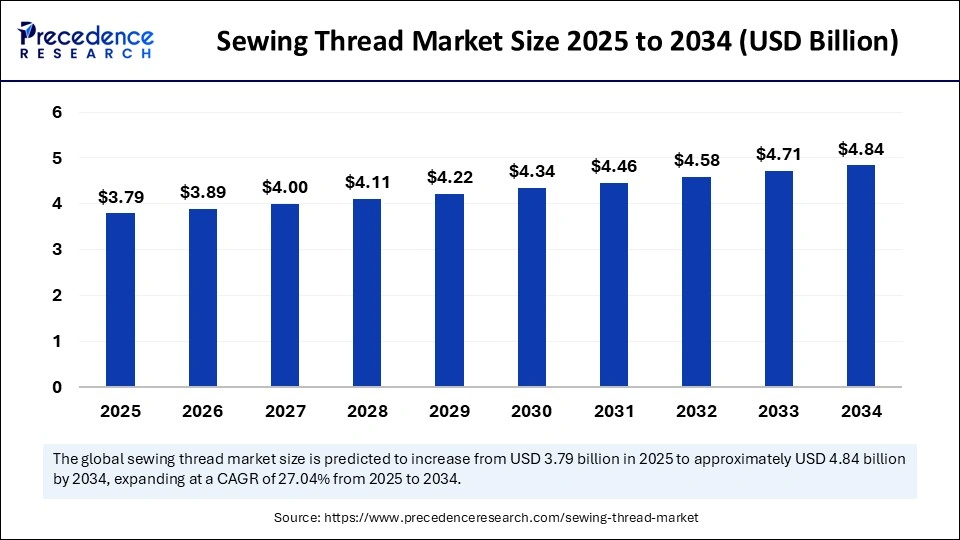
Sewing Thread Market Key Takeaways
- In terms of revenue, the market is valued at 3.79 billion in 2025.
- It is projected to reach 4.84 billion by 2034.
- The market is expected to grow at a CAGR of 2.74% from 2025 to 2034.
- Asia Pacific dominated the global market with the largest market share of 48% in 2024.
- North America is anticipated to grow at the fastest CAGR during the forecast period.
- By application, the apparel segment held the major market share in 2024.
- By application, the footwear segment is expected to witness the fastest growth during the predicted timeframe.
- By type, the synthetic segment captured the biggest market share of 61% in 2024.
- By type, the natural segment is expected to grow at the fastest CAGR in the upcoming years.
- By distribution channel, the specialty stores segment held a major market share of 37.20% in 2024.
- By distribution channel, the online sales segment is expected to grow at a significant CAGR over the projected period.
How does Artificial Intelligence Impact the Sewing Thread Market?
Artificial intelligence is transforming the sewing thread market, primarily by enhancing quality control and optimizing production processes, such as automating bobbin changes, adjusting stitching parameters, and improving supply chain management. AI-powered systems can detect defects in threads, automate processes like bobbin changing and stitching adjustments, and even predict the need for different types of threads. Moreover, manufacturers can determine the optimal amount of thread to order and store, thereby reducing waste and costs.
Asia Pacific Sewing Thread Market Size and Growth 2025 to 2034
Asia Pacific sewing thread market size was exhibited at USD 1.77 billion in 2024 and is projected to be worth around USD 2.35 billion by 2034, growing at a CAGR of 2.87% from 2025 to 2034.
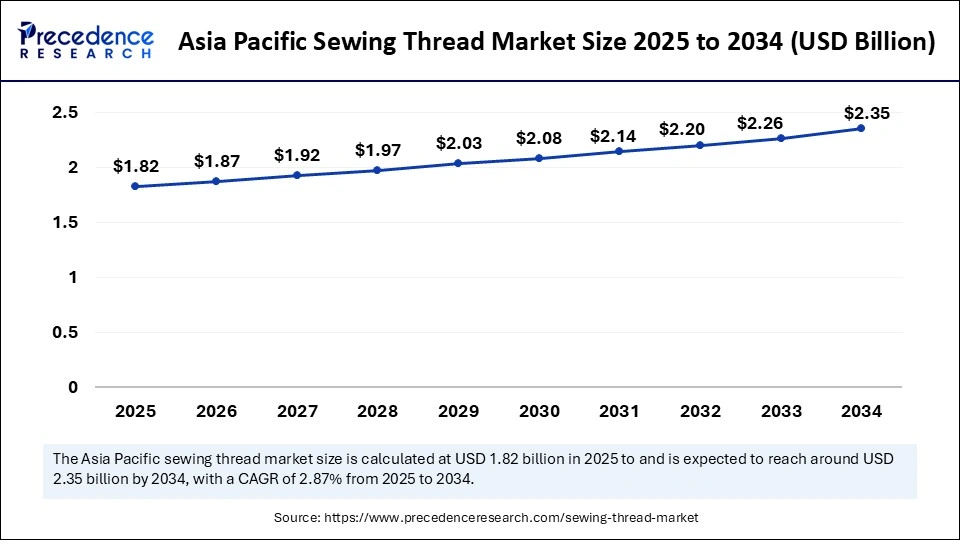
What Factors Drive Asia Pacific's Lead in the Sewing Thread Market?
Asia Pacific dominated the sewing thread market by holding the largest share in 2024. This is mainly due to its well-established textile and garment manufacturing base. The region is considered a global hub for textile and apparel production, propelling the demand for sewing threads. The region not only offers abundant and relatively inexpensive labor, but it also has access to raw materials, making it a cost-effective manufacturing hub where countries like China, India, and Bangladesh are major contributors. The textile industry in the region is also increasingly adopting automation and digitalization to boost production processes and quality, coupled with several governments in the region actively promoting automation in the textile sector to boost apparel production. As the production of apparel rises, so does the need for sewing threads, sustaining the long-term growth of the market.
Indian Sewing Thread Market Trends
India is a major player in the market due to its position as a major producer of textiles and clothing, including sewing threads, making it the world's largest exporter of textiles and apparel. The textile industry is one of the major sources of employment in the country. The Indian Government, in order to achieve the Textile 2030 vision, has been focusing on high-tech and high-growth product segments, leveraging inherent strengths, and developing large-scale plug-and-play infrastructure by keeping sustainability at the core. The major schemes in India include PM Mega Integrated Textile Regions and Apparel (PM MITRA) Parks Scheme that seeks to create a modern, integrated, world-class textile infrastructure; Production Linked Incentive (PLI) Scheme focusing on Man-Made Fibre (MMF) Fabric, MMF Apparel and Technical Textiles to boost large scale manufacturing and enhancing competitiveness; National Technical Textiles Mission focusing on Research Innovation & Development, Promotion and Market Development; and SAMARTH – Scheme for Capacity Building in Textile Sector with the objective providing demand driven, placement oriented, skilling program. Such schemes are likely to drive market growth in the country.
(Source: https://www.pib.gov.in)
China: A Key Hub in the Production of the Sewing Thread
China plays a crucial role in the sewing thread market. As the largest producer and exporter of textiles and apparel worldwide, China also produces sewing threads. Furthermore, China has been developing advanced standards for textile testing and quality accreditation that align with international standards. Additionally, the country can produce a wide range of synthetic fabrics, such as polyester and georgette, which enhances the significance of sewing thread production.
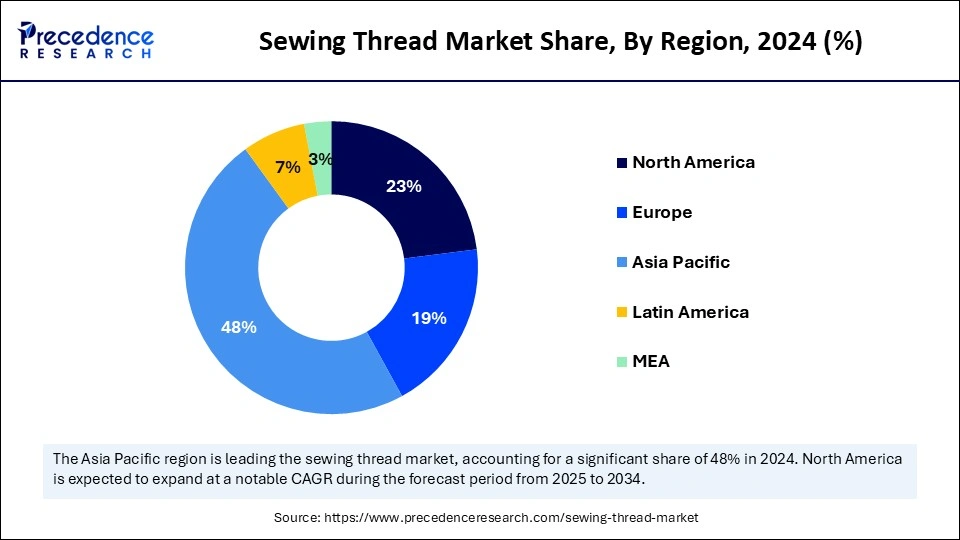
What Opportunities Exist in the North America Sewing Thread Market?
North America is anticipated to grow at the fastest rate in the market during the forecast period. This is because the region has a well-established textile and apparel industry with a strong base of manufacturers and designers. Furthermore, advanced manufacturing technologies and an increasing focus on sustainable practices in the textile industry, including the use of recycled materials, eco-friendly dyes, and water-efficient manufacturing processes, contribute to market growth. Additionally, governments in North America are working to develop a more suitable environment for trade, which aims to stimulate growth in the textile and apparel sectors.
The U.S Sewing Thread Market Trends
The U.S. plays a significant role in the sewing thread market, bolstered by a strong textile and apparel industry that increases the demand for sewing threads, especially for durable and high-quality products. Additionally, growing disposable incomes and changing consumer preferences, favoring fashionable and durable clothing, drive market expansion. Furthermore, the U.S. market benefits from a focus on innovation in thread manufacturing techniques, leading to diverse applications in fashion and technical textiles.
Europe: A Notable Region in the Sewing Thread Market
Europe is expected to grow at a considerable rate in the upcoming period. This is due to the region's long history and strong presence in the textile and apparel industry, spurring demand for sewing threads across various applications, from garment manufacturing to bespoke tailoring. Additionally, the increasingly developing DIY sewing culture, influenced by trends like sustainable consumption and the necessity for personalized clothing, leads to increased demand for sewing threads.
The EU Strategy for Sustainable and Circular Textiles addresses the production and consumption of textiles by recognizing the importance of the textiles sector. It implements the commitments of the European Green Deal, the Circular Economy Action Plan, and the European industrial strategy. The strategy aims at enhancing the entire lifecycle of textile products and proposes coordinated actions to change the production and consumption of textiles.
(Source: https://environment.ec.europa.eu)
Market Overview
The sewing thread market encompasses the production and distribution of threads used to join fabric pieces in garments, accessories, and other textile products like apparel, footwear, and home textiles. The market is witnessing rapid growth due to the growing demand for sewing threads in the apparel and footwear sectors. Technological advancements in thread production and expanding applications in diverse industries, such as medical sutures and technical textiles, further support market expansion.
What are the Key Trends in the Sewing Thread Market?
- Technological Innovation: Fast fashion trends and rising disposable incomes are resulting in increased thread advancements in production techniques, leading to stronger and more versatile threads with high performance, along with more durability.
- Wide Range of Applications: The sewing thread is extending its applications beyond traditional apparel and footwear into other sectors like automotive, home interiors, and even specialized fields like medical sutures and technical textiles.
- Demand for Synthetic Thread: Synthetic threads like polyester and nylon are gaining popularity due to their resilience and suitability for various applications, such as high-stress environments in technical textiles.
- Demand for Recycled Thread: The rise in environmentally conscious consumers is empowering demand for natural fiber threads. Further, this increased interest in sustainable practices is contributing to the necessity for recycled threads.
Market Scope
| Report Coverage | Details |
| Market Size by 2034 | USD 4.84 Billion |
| Market Size in 2025 | USD 3.79 Billion |
| Market Size in 2024 | USD 3.69 Billion |
| Market Growth Rate from 2025 to 2034 | CAGR of 2.74% |
| Dominating Region | Asia Pacific |
| Fastest Growing Region | North America |
| Base Year | 2024 |
| Forecast Period | 2025 to 2034 |
| Segments Covered | Application, Type, Distribution, and Region |
| Regions Covered | North America, Europe, Asia-Pacific, Latin America, and Middle East & Africa |
Market Dynamics
Drivers
Expansion of the Textile & Apparel Industry
The primary driver of the sewing thread market is the expansion of the textile and apparel industry, which is further attributed to the rising consumer demand for apparel and footwear. Additionally, the demand for affordable and high-quality garments, especially in fast fashion, fuels the need for sewing threads. Consumers are increasingly seeking trendy, comfortable, and durable footwear that requires sewing threads.
Restraint
Higher Cost of Raw Materials
A major constraint in the sewing thread market is the higher cost of raw materials, particularly natural and synthetic fibers like cotton, polyester, and nylon. Fluctuations in the price of raw materials significantly impact production expenses, making it challenging for manufacturers to maintain stable pricing and potentially harming profit margins. Moreover, the environmental impact of textile production and the availability of counterfeit threads hinder the growth of the market.
Opportunity
The Increasing Demand for Sustainable and Eco-Friendly Threads
The increasing demand for sustainable and eco-friendly threads is expected to create immense opportunities in the sewing thread market. This encompasses threads made from recycled materials, organic fibers, and other environmentally friendly sources. Furthermore, consumers and manufacturers are increasingly prioritizing sustainable products and processes. This shift toward sustainable threads is anticipated to greatly affect the sewing thread market, leading to heightened competition, innovation, and investment in sustainable production methods.
Application Insights
The apparel segment held the major share of the sewing thread market in 2024 due to the mass production of clothing, which requires vast quantities of sewing thread to assemble garments in the apparel industry. The reliance of the apparel industry on sewing threads makes it the largest consumer of this product. Furthermore, the apparel industry is propelled by fashion trends and the constant demand for new designs, necessitating a variety of sewing thread types and colors.
The footwear segment is expected to witness the fastest growth during the predicted timeframe, driven by the increased demand for comfortable shoes. Technological advancements, such incorporation of sensors, GPS, and fitness tracking features in smart shoes, are propelling the demand for specialized threads, especially in the athleisure and smart footwear sectors. The segmental growth is further attributed to innovations like smart shoes with embedded technology and the rise of performance-oriented footwear, which ensures long-lasting performance in various environments.
Type Insights
The synthetic segment captured the biggest share of the sewing thread market in 2024. This is due to the synthetic sewing thread's superior properties like strength, durability, and resistance to chemicals and moisture, making them ideal for industrial and high-performance applications. As synthetic fibers like polyester and nylon provide greater tensile strength and abrasion resistance compared to natural fibers like cotton, together with their less susceptibility to degradation from moisture, chemicals, and UV exposure, they ensure long-lasting performance in various environments. Furthermore, they can be tailored to specific demands with different finishes, textures, and colors, and therefore, customized solutions in apparel, automotive, and industrial sectors.
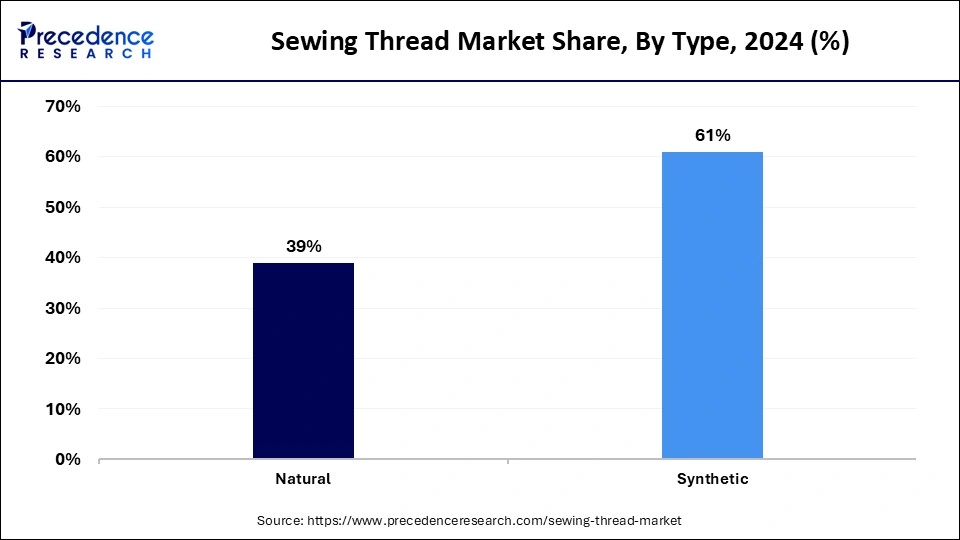
- In March 2022, the international sewing thread producer Amann Group launched a sewing thread that is entirely made from basalt stone fibers. Basalt facilitates special characteristics beneficial for a variety of different applications. As Basalt-tech withstands even the highest temperatures, it has become a preferred option for protective workwear with maximum heat load, hot gas filtration, or applications with liquid metal contact.
(Source: https://textile-network.com)
The natural segment is expected to grow at the fastest rate in the upcoming years, owing to increasing consumer demand for sustainable and eco-friendly products. Natural threads, like cotton, silk, and linen, are biodegradable and have a lower environmental impact than synthetic alternatives. Furthermore, the textile industry depends on natural threads for their durability and compatibility with natural fibers, boosting product quality. Additionally, research and development endeavors emphasize improving natural threads' strength, durability, and dyeability, making them more competitive with synthetic alternatives.
Distribution Channel Insights
The specialty stores segment held a dominant share of the sewing thread market in 2024. This is mainly due to the increased demand for specialized sewing threads that cater to specific customer segments, due to their ability to provide curated selections, personalized service, and expertise within niche markets. These stores cater to hobbyists, DIY enthusiasts, and small-scale tailors by providing high-quality threads. The availability of a range of thread types in these stores increases customer footfall.
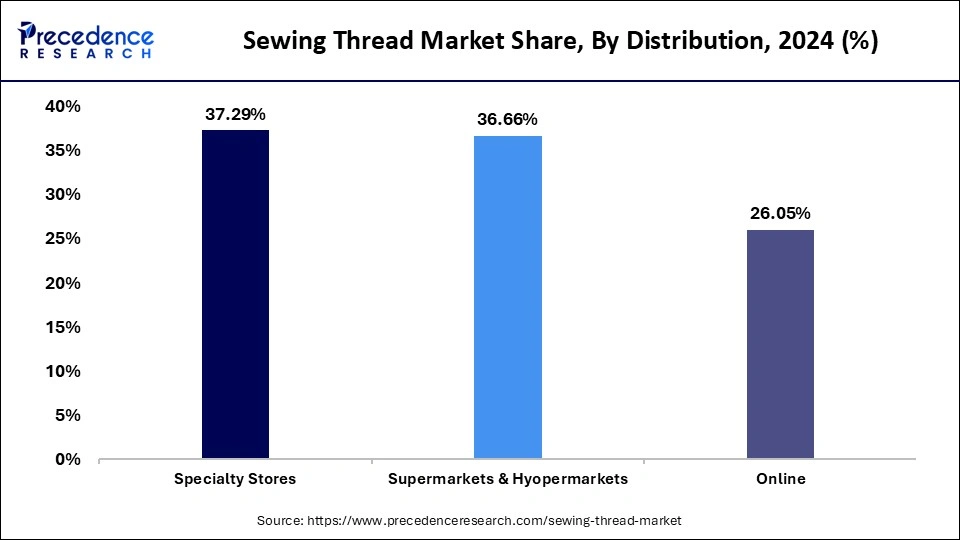
The online sales segment is expected to grow at a significant CAGR over the projected period due to convenience, wider product selection, and global reach. Online platforms allow customers to browse, compare, and purchase sewing threads from the comfort of their homes, saving time and effort. Additionally, digital platforms and technologies are propelling the shift toward online sales by facilitating new ways to connect with customers and improve the shopping experience.
Competitive Landscape
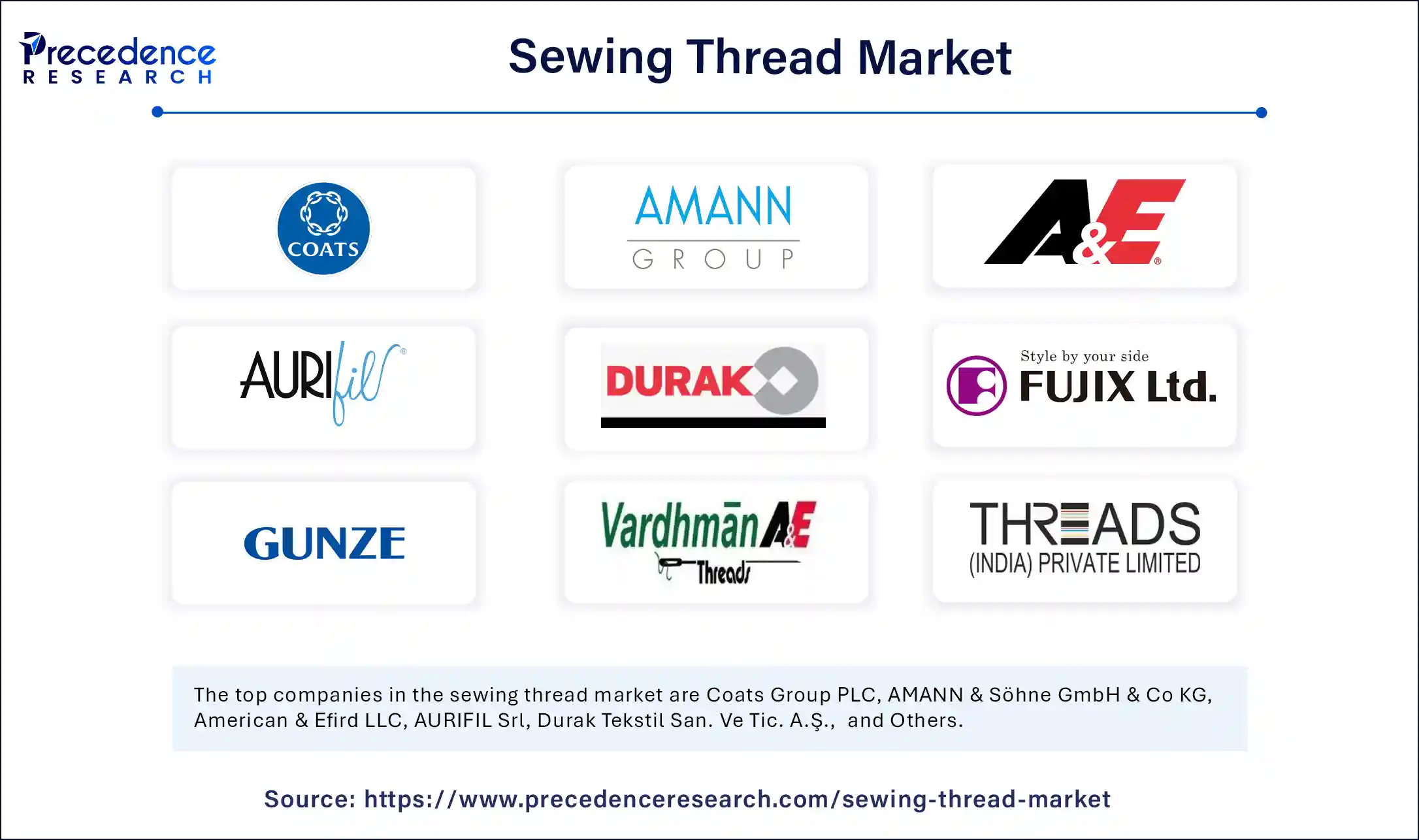
- Coats Group PLC
- AMANN & Söhne GmbH & Co KG
- American & Efird LLC
- AURIFIL Srl
- Durak Tekstil San. Ve Tic. A.Ĺž.
- FUJIX Ltd.
- Gunze Limited
- Vardhman Yarns & Threads Ltd.
- Threads (India) Private Limited
- Ningbo MH Industry Co., Ltd.
- Leader Thread Corp.
- Eddington Thread Manufacturing Co.
- W.L. Gore & Associates, Inc.
- Perfectex Plus LLC
- Canwil Textiles, Inc.
Leader's Announcement
- In November 2023, Adrian Elliott, CEO of the apparel division at Coats Group, announced that, a thread and structural components manufacturer Coats Group received the Cradle-to-Cradle Certified Material Health Certificate for its eco-friendly sewing thread solutions with a commitment to safe, circular, and sustainable products.
(https://www.just-style.com)
Recent Developments
- In July 2024, AMANN's new state-of-the-art production site in India promises a greener future for the thread industry. As AMANN has been present in India for more than 15 years, and has been offering high-quality sewing and embroidery threads for thriving apparel of India, footwear, and the leather market, by serving as the central hub for producing high-quality sewing thread across various applications.
(Source: https://apparelresources.com) - In May 2024, Coloreel, a pioneer in innovative thread dyeing technology, collaborated with Juki America, a leading provider of sewing solutions. This partnership marks a significant leap forward, opening real-time, on-demand thread dyeing capabilities to the sewing market for the first time, aiming for both precision and flexibility in their creations.
(Source: https://www.texintel.com)
Segments Covered in the Report
By Application
- Apparel
- Footwear
- Beddings & Mattress
- Others
By Type
- Natural
- Synthetic
By Distribution
- Supermarkets & Hypermarkets
- Specialty Stores
- Online Stores
By Region
- North America
- Europe
- Asia Pacific
- Latin America
- Middle East and Africa
For inquiries regarding discounts, bulk purchases, or customization requests, please contact us at sales@precedenceresearch.com
Frequently Asked Questions
Ask For Sample
No cookie-cutter, only authentic analysis – take the 1st step to become a Precedence Research client